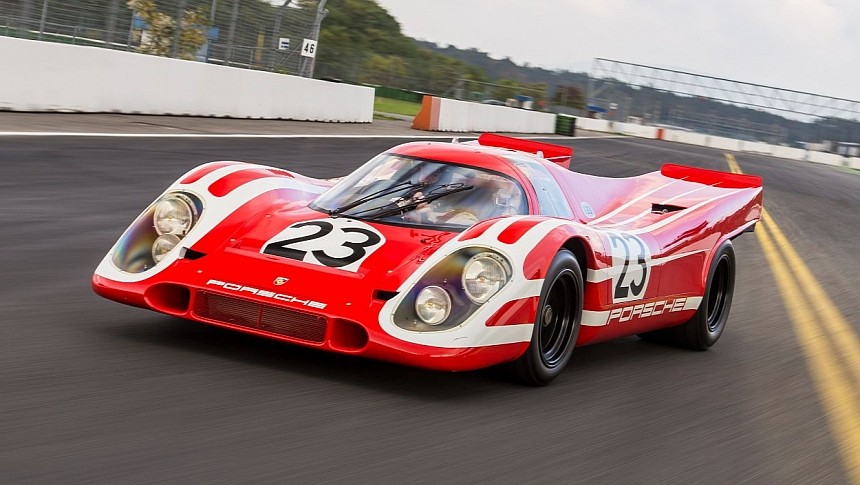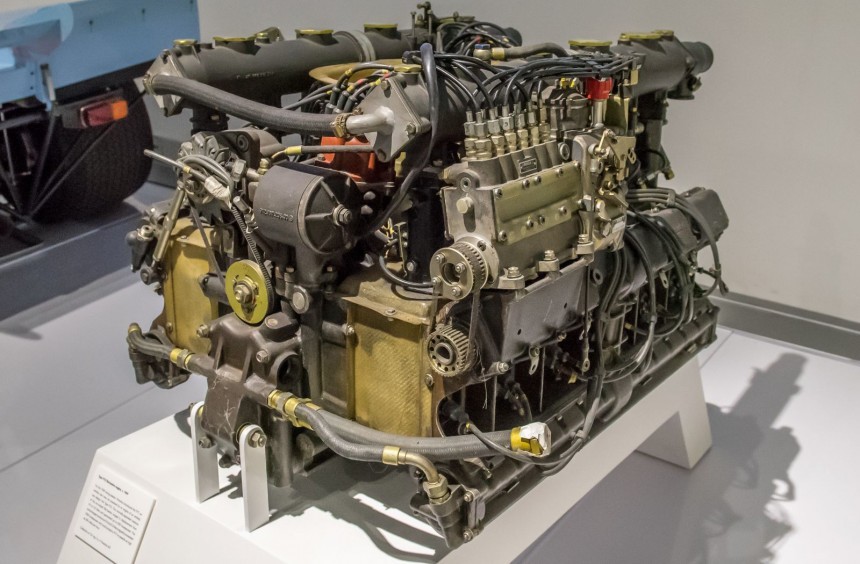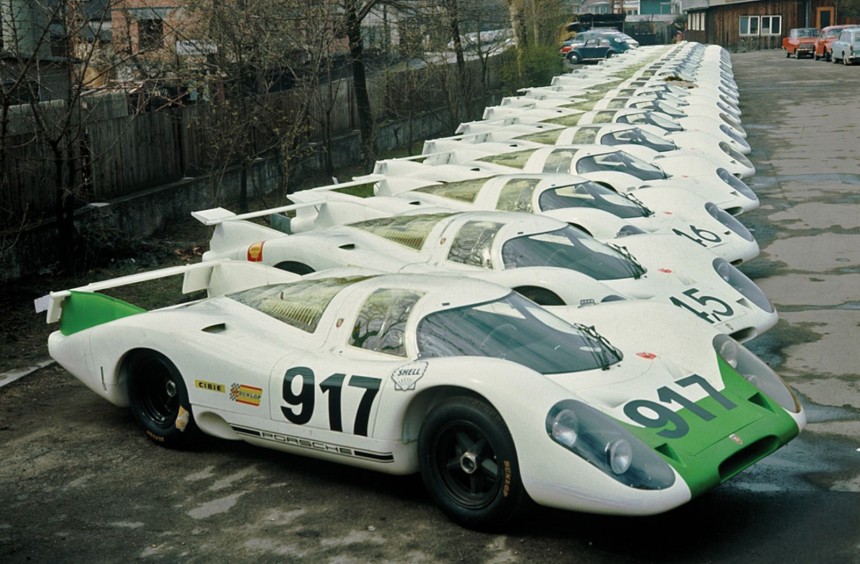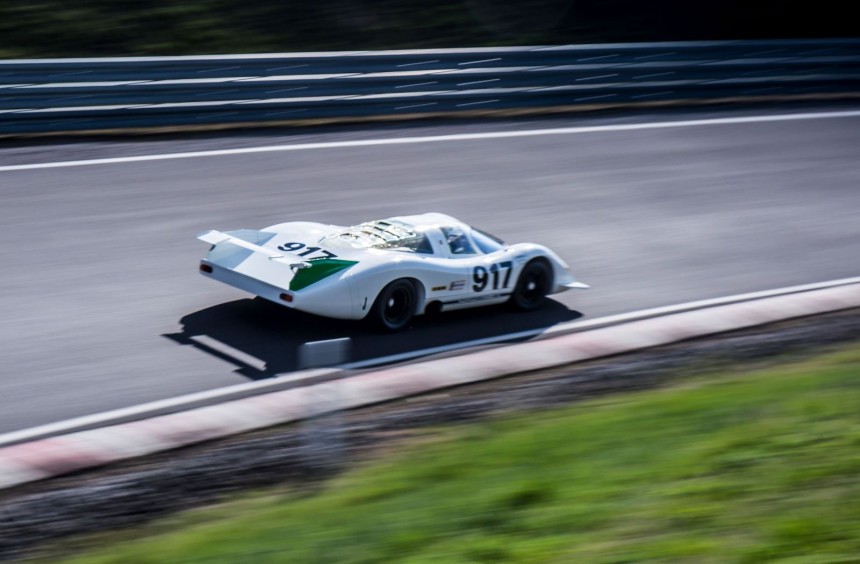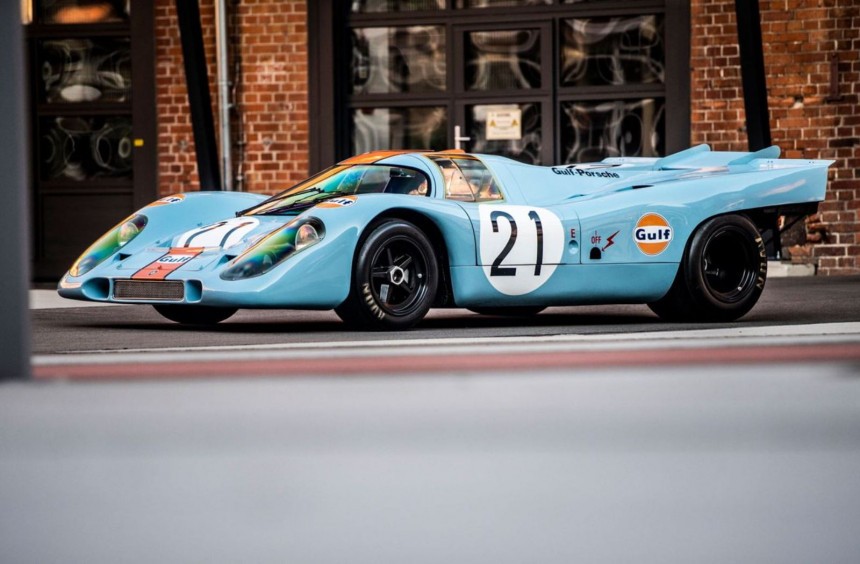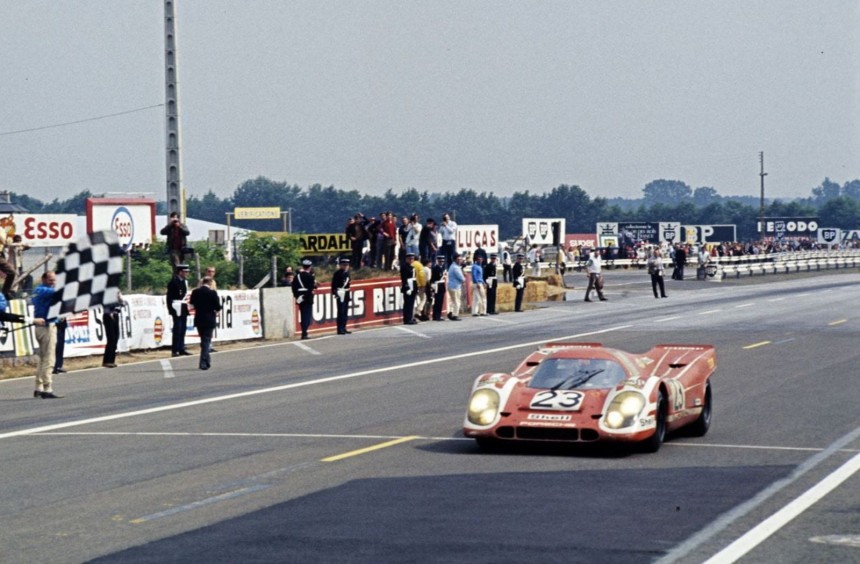Considered one of the best race cars ever built, the 917 brought Porsche its first two 24 Hours of Le Mans victories. It also inspired the creation of future prototypes that transformed Porsche into the most successful manufacturer in the world of endurance racing.
Today, the Zuffenhausen-based brand is one of the most important European carmakers and, thanks to its brilliant 911, a big player in the sports car market.
Unlike today, back in the 1950s, Porsche was still a small manufacturer, especially when compared to the likes of Ferrari or cross-town rivals Mercedes.
Despite this, Porsche made a name for itself in motorsport thanks to the legendary 550 and its successor, the 718.
By the 1960s, the Germans stepped up and competed in the higher categories of sports car races, but a major achievement, like winning the famed 24 Hours of Le Mans endurance race, had eluded them.
Although they struggled against big-money projects from Ferrari or Ford, Porsche kept at it and slowly but surely climbed up the ranks.
As Porsche finished fifth with their latest 907 prototype at Le Mans in 1967, the Commission Sportive Internationale (then independent from FIA) announced a controversial change to World Sportscar Championship regulations.
The new rules limited Group 6 engine displacement to 3.0 liters for four years, from 1968 through 1971, as the CSI hoped to tame the dangerously fast prototypes and attract Formula 1 3.0-liter engine manufacturers to adapt them for endurance racing.o
But, since the CSI knew this change would upset many carmakers (like Ferrari, who dropped out of the 1968 WSC season), Group 4 sports cars could now use engines of up to 5.0 liters.
However, Group 4 sports cars had to be produced in at least 50 units (later dropped to 25)and needed to be technically street-legal.
That meant the cars had to have features like a turn-key ignition, a passenger seat, a spare tire, and minimal room for luggage.
Porsche improved their existing 907 Group 6 prototype and equipped it with a new 3.0-liter flat-eight, but only came second at Le Mans in 1968, behind John Wyer's GT40 MK I, which took advantage of the Group 4 loophole.
The Germans won the WSC title that season, but the Le Mans defeat hurt so bad that only a month after the race, motorsports chief Ferdinand Piëch decided to borrow John Wyer's recipe.
Unlike the Mk I GT40, which abided by the Group 4 rules, Porsche didn't have the car or the engine to pose a threat but decided to build both with just months to spare and started with an all-new flat-twelve.
Therefore, in June 1968, the Porsche engineers, led by the legendary Hanz Mezger, received the green light to start building the engine.
Mind you, by that time, Porsche had developed quite a few flat-fours, flat-sixes, and even a flat-eight, but they had yet to attempt building a flat-twelve.
Nevertheless, it was finished in just around six months, partially because Mezger had the brilliant idea of fuzing two existing six-cylinder blocks.
Furthermore, he decided to harness the power from the middle of the crankshaft via a central gearing mechanism, which helped minimize crankshaft vibration, and used exotic alloys like titanium and magnesium.
The result was a 4.5-liter powerhouse that effortlessly made around 550 hp. More importantly, initial bench tests hinted that the Type 912 Flat-twelve could sustain high-rpm operation for prolonged periods, which was precisely what was needed to win at Le Mans.
During that era, race car development was transitioning to the boxed aluminum monocoque chassis pioneered by Lotus in Formula 1.
Porsche elected to continue building a traditional, lightweight space frame chassis for the new car. However, the aluminum tubes were flawlessly welded together and permanently pressurized with gas to detect eventual cracks.
The innovative chassis that weighed only around 105 pounds (47.6 kg) received an all-new, wind tunnel-developed, low-drag fiberglass body that was subsequently bonded to the spaceframe to increase rigidity.
To take advantage of the Group 4 loophole, the body was equipped with turn-key ignition, a tiny passenger seat, a space-saver spare, and two luggage compartments underneath the rear spoiler.
Mind-blowingly, Porsche managed to build 25 units of the new 917 in just ten months - one month ahead of the homologation deadline for the 1969 season.
When finished, the 917 was so light, streamlined, and powerful that it could reach a top speed of 220 mph (354 kph).
But, despite its power potential, speed, lightweight construction, and formidable braking system, the car was just too unstable at high speeds.
Porsche drivers could not tame it, and it got to a point where some refused to race the 917, which by then earned the nickname "Widowmaker."
Still, Vic Elford, Richard Attwood, Rolf Stommelen, and Kurt Ahrens Jr. were convinced to drive the two 917s scheduled to debut at the 1969 edition of Le Mans.
As expected, one car was involved in a serious crash, while the other retired due to a lubrication system failure.
Meanwhile, John Wyer's team, with its GT40 Mk I, crossed the finish line first yet again.
After Le Mans, the initial 917, known as 917 LH (Langheck in German, or long tail in English), competed at the last race on the 1969 WSC calendar held in Austria, where it won - much to everyone's surprise.
Before leaving Austria, Porsche management convinced John Wyer to switch alliances and use the 917 throughout the 1970 season.
With Wyer and his engineers on site, the 917 was thoroughly tested, and its entire rear end was redesigned entirely - initially by using gaffer tape and sheets of aluminum shaped on the side of the Zeltweg track in Austria.
With a new short (kurz in German) tail and many other small upgrades, the new 917 K was a vast improvement over its predecessor.
The 917 K was fully developed in time for the 1970 WSC season. It debuted at the opening 24 Hours of Daytona race, which it won comfortably.
After that, the 917 K won six of the remaining nine races, including Le Mans, where the no. 23 Porsche Szalburg car, co-driven by Hans Herrmann and Richard Attwood, brought Porsche its first win at the iconic endurance race.
With an engine bored out to 4.9 liters and aerodynamic improvements, the 917K remained dominant throughout the 1971 season, helping Porsche defend its WSC title (the third in a row) and fetching another Le Mans win.
The no. 22 car of Gijs van Lennep and Helmut Marko averaged a speed of 138 (222 kph), covering a distance of 3,315 miles (5,335km) – over 435 miles (700 km) more 1970 917K. These new records were so impressive that they were only broken in 2010.
Porsche retired the 917K from the WSC after that season, but a modified open-top version with a twin-turbo flat-twelve competed in the American Can-Am series, winning the 1972 championship.
Its successor, the revised, 1,580-hp capable 917/30, repeated the performance in 1973 and solidified the 917's legacy.
Today, 55 years after its debut, the 917 is still rightfully considered one of the best race cars ever built, and thanks to the lessons learned during its development, Porsche became the biggest name in endurance racing.
For the detailed story of this fascinating race car, we recommend watching the YouTube video below by VINwiki.
Unlike today, back in the 1950s, Porsche was still a small manufacturer, especially when compared to the likes of Ferrari or cross-town rivals Mercedes.
Despite this, Porsche made a name for itself in motorsport thanks to the legendary 550 and its successor, the 718.
By the 1960s, the Germans stepped up and competed in the higher categories of sports car races, but a major achievement, like winning the famed 24 Hours of Le Mans endurance race, had eluded them.
Although they struggled against big-money projects from Ferrari or Ford, Porsche kept at it and slowly but surely climbed up the ranks.
The loophole in the regulations
The new rules limited Group 6 engine displacement to 3.0 liters for four years, from 1968 through 1971, as the CSI hoped to tame the dangerously fast prototypes and attract Formula 1 3.0-liter engine manufacturers to adapt them for endurance racing.o
But, since the CSI knew this change would upset many carmakers (like Ferrari, who dropped out of the 1968 WSC season), Group 4 sports cars could now use engines of up to 5.0 liters.
However, Group 4 sports cars had to be produced in at least 50 units (later dropped to 25)and needed to be technically street-legal.
That meant the cars had to have features like a turn-key ignition, a passenger seat, a spare tire, and minimal room for luggage.
Porsche improved their existing 907 Group 6 prototype and equipped it with a new 3.0-liter flat-eight, but only came second at Le Mans in 1968, behind John Wyer's GT40 MK I, which took advantage of the Group 4 loophole.
The Germans won the WSC title that season, but the Le Mans defeat hurt so bad that only a month after the race, motorsports chief Ferdinand Piëch decided to borrow John Wyer's recipe.
Starting with a new engine
Therefore, in June 1968, the Porsche engineers, led by the legendary Hanz Mezger, received the green light to start building the engine.
Mind you, by that time, Porsche had developed quite a few flat-fours, flat-sixes, and even a flat-eight, but they had yet to attempt building a flat-twelve.
Nevertheless, it was finished in just around six months, partially because Mezger had the brilliant idea of fuzing two existing six-cylinder blocks.
Furthermore, he decided to harness the power from the middle of the crankshaft via a central gearing mechanism, which helped minimize crankshaft vibration, and used exotic alloys like titanium and magnesium.
The result was a 4.5-liter powerhouse that effortlessly made around 550 hp. More importantly, initial bench tests hinted that the Type 912 Flat-twelve could sustain high-rpm operation for prolonged periods, which was precisely what was needed to win at Le Mans.
Building a new car around the engine
Porsche elected to continue building a traditional, lightweight space frame chassis for the new car. However, the aluminum tubes were flawlessly welded together and permanently pressurized with gas to detect eventual cracks.
The innovative chassis that weighed only around 105 pounds (47.6 kg) received an all-new, wind tunnel-developed, low-drag fiberglass body that was subsequently bonded to the spaceframe to increase rigidity.
To take advantage of the Group 4 loophole, the body was equipped with turn-key ignition, a tiny passenger seat, a space-saver spare, and two luggage compartments underneath the rear spoiler.
Mind-blowingly, Porsche managed to build 25 units of the new 917 in just ten months - one month ahead of the homologation deadline for the 1969 season.
The widowmaker
But, despite its power potential, speed, lightweight construction, and formidable braking system, the car was just too unstable at high speeds.
Porsche drivers could not tame it, and it got to a point where some refused to race the 917, which by then earned the nickname "Widowmaker."
Still, Vic Elford, Richard Attwood, Rolf Stommelen, and Kurt Ahrens Jr. were convinced to drive the two 917s scheduled to debut at the 1969 edition of Le Mans.
As expected, one car was involved in a serious crash, while the other retired due to a lubrication system failure.
Meanwhile, John Wyer's team, with its GT40 Mk I, crossed the finish line first yet again.
From the lackluster 910into the mighty 917K
Before leaving Austria, Porsche management convinced John Wyer to switch alliances and use the 917 throughout the 1970 season.
With Wyer and his engineers on site, the 917 was thoroughly tested, and its entire rear end was redesigned entirely - initially by using gaffer tape and sheets of aluminum shaped on the side of the Zeltweg track in Austria.
With a new short (kurz in German) tail and many other small upgrades, the new 917 K was a vast improvement over its predecessor.
Becoming one of the best race cars of all time
After that, the 917 K won six of the remaining nine races, including Le Mans, where the no. 23 Porsche Szalburg car, co-driven by Hans Herrmann and Richard Attwood, brought Porsche its first win at the iconic endurance race.
With an engine bored out to 4.9 liters and aerodynamic improvements, the 917K remained dominant throughout the 1971 season, helping Porsche defend its WSC title (the third in a row) and fetching another Le Mans win.
The no. 22 car of Gijs van Lennep and Helmut Marko averaged a speed of 138 (222 kph), covering a distance of 3,315 miles (5,335km) – over 435 miles (700 km) more 1970 917K. These new records were so impressive that they were only broken in 2010.
Porsche retired the 917K from the WSC after that season, but a modified open-top version with a twin-turbo flat-twelve competed in the American Can-Am series, winning the 1972 championship.
Its successor, the revised, 1,580-hp capable 917/30, repeated the performance in 1973 and solidified the 917's legacy.
Today, 55 years after its debut, the 917 is still rightfully considered one of the best race cars ever built, and thanks to the lessons learned during its development, Porsche became the biggest name in endurance racing.
For the detailed story of this fascinating race car, we recommend watching the YouTube video below by VINwiki.
